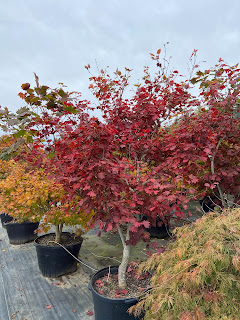Cultivating Acer japonicum Maples: A Guide to Successful Growth
Acer japonicum Maples
Acer japonicum, commonly known as Japanese maple, is a stunning ornamental tree admired for its vibrant foliage and graceful form. Among its varieties, Acer japonicum Maples stand out for their unique leaf shapes and brilliant fall colors, making them prized additions to gardens and landscapes. Cultivating these exquisite trees requires attention to detail and proper care throughout the seasons. In this guide, we'll explore essential tips for nurturing healthy Acer japonicum Maples, covering the right seasons to grow, necessary care, watering techniques, mulching, fertilization, shade considerations, and more.
1. Choosing the Right Season to Grow:
Acer japonicum Maples are best planted in early spring or fall when the weather is mild, and the soil is moist. Planting during these seasons allows the tree to establish its roots before the onset of harsh weather conditions. Avoid planting during the peak of summer or winter when extreme temperatures can stress the tree.
2. Proper Care Requirements:
Soil: Acer japonicum Maples thrive in well-drained, slightly acidic soil with a pH range of 5.5 to 6.5. Ensure the soil is rich in organic matter and provides good aeration for root development.
Sunlight: These maples prefer partial shade to full shade, especially during the hot afternoon hours. However, some varieties can tolerate more sun if provided with adequate moisture and protection from intense sunlight.
3. Watering Techniques:
Consistent Moisture: Adequate moisture is crucial, especially during the tree's establishment phase. Water deeply and regularly, keeping the soil consistently moist but not waterlogged. Mulching can help retain soil moisture.
Drought Tolerance: Once established, Acer japonicum Maples demonstrate moderate drought tolerance. However, during prolonged dry spells, supplemental watering may be necessary to maintain tree health and vigor.
4. Mulching:
Benefits: Apply a layer of organic mulch, such as shredded bark or compost, around the base of the tree. Mulching helps conserve soil moisture, regulate soil temperature, suppress weed growth, and improve soil structure over time.
Application: Spread mulch evenly around the root zone, keeping it a few inches away from the trunk to prevent moisture buildup and potential rotting issues.
5. Fertilization:
Timing: Fertilize Acer japonicum Maples in early spring before new growth emerges or in late fall after leaf drop. Avoid fertilizing during the dormant winter months.
Type: Use a balanced slow-release fertilizer formulated for trees and shrubs, following the manufacturer's instructions for application rates. Avoid excessive nitrogen, as it can promote lush foliage at the expense of root and stem development.
6. Shade Considerations:
Ideal Conditions: While Acer japonicum Maples prefer partial shade, they can also thrive in full shade conditions, particularly in regions with hot summers. Planting them in locations with dappled sunlight or morning sun with afternoon shade is ideal.
Protection: Protect young trees from intense sunlight and heat stress by providing temporary shade structures or planting them near taller trees that can offer shade during the hottest part of the day.
In conclusion, cultivating Acer japonicum Maples requires attention to specific growing conditions and care practices to ensure optimal health and beauty. By planting them in the right season, providing proper care, watering appropriately, mulching, fertilizing, and considering shade requirements, gardeners can enjoy the splendor of these exquisite trees in their landscapes for years to come. With patience and dedication, Acer japonicum Maples will reward growers with their stunning foliage and graceful presence, enhancing any outdoor space they inhabit.






.png)
Comments
Post a Comment